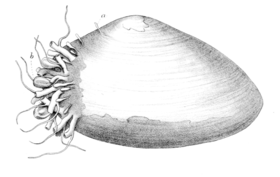Limnomedusae
| Limnomedusae | ||||||||||
|---|---|---|---|---|---|---|---|---|---|---|

Olindias formosa |
||||||||||
| Systematics | ||||||||||
|
||||||||||
| Scientific name | ||||||||||
| Limnomedusae | ||||||||||
| Kramp , 1938 |
The Limnomedusae (also Limnohydrina or Limnopolypae) are an order of the hydrozoans within the cnidarians (Cnidaria). It includes some forms that live in fresh water. However, most forms live in the sea. About 54 species are currently known. In the meantime, Craspedacusta sowerbyii , which comes from East Asia, has also been transported to some lakes in Germany.
features
The limnomedusae are mostly metagenetic cnidarians with a polyp and a Medusenstadium . The species of the genus Monobrachium , which have reduced the medusa stage, are probably an exception . In some species, the medusa stage is stuck to the polyp.
The polyps are sessile, mostly small and relatively simple. They have tentacles; some species are also without tentacles. They are naked or have a periderm made of mucoproteins . Most species live solitary , but some species also form colonies.
The medusas usually have four, but also up to six radial canals that extend to the manubrium . Often there are also centropetal canals that do not reach the manubrium. A marginal ring of nematocysts may or may not be present. The gonads are formed along the radial canals, rarely also on the manubrium (genera Armorhydra and Limnocnida ). The marginal tentacles are hollow towards the tip; they have no real basal swelling. The nettle cells belong to the micro- and macrobasic Euryteles present. On the sensory organs statocysts are present at the edge of the screen , which are enclosed in the mesogloea near the ring canal or the velum .
The species of Limnomedusae reproduce asexually through podocysts or wandering frustules, which are worm-like structures that can move around. Medusa formation occurs metagenetically through lateral budding on the polyp.
Geographical occurrence and way of life
Most species live in the sea or in brackish water, a few species also in fresh water. They are spread almost worldwide. Craspedacusta sowerbyii is a neozoon in Europe that was first described in Europe as early as 1880.
Systematics
According to the first molecular genetic studies by Collins et al. (2006) the Limnomedusae are paraphyletic and are at the base of the Trachylina. However, only representatives of the Monobrachiidae and Olindiidae were included in the analysis. There is also relatively good evidence that the Geryoniidae family (previously order Trachymedusae ) is probably derived from the Limnomedusae. The position of the Armorhydridae is basically completely unclear , since it does not share any potentially derived characteristics with the other representatives of the Limnomedusae. Their medusas, which live in the interstitial , also differ from the medusas of other Limnomedusae in some features. The position of the Microhydrulidae within the Limnomedusae is only to be regarded as provisional, since the medusa stage is unknown. The conservative system of Daly et al. (2007) and by Peter Schuchert (Hydrozoa Directory) is as follows:
- Order Limnomedusae Kramp, 1938
- Armorhydridae family Swedmark & Teissier, 1958
- Genus Armorhydra Swedmark & Teissier, 1958
- Armorhydra janowiczi Swedmark & Teissier, 1958
- Genus Armorhydra Swedmark & Teissier, 1958
- Family Microhydrulidae Bouillon & Deroux, 1967 (2 genera)
- Genus Microhydrula Valkanov, 1965
- Microhydrula limopsicola Jarms & Tiemann 1996
- Microhydrula pontica Valkanov, 1965
- Genus Rhaptapagis Bouillon & Deroux, 1967
- Rhaptapagis cantacuzenei Bouillon & Deroux, 1967
- Genus Microhydrula Valkanov, 1965
- Family Monobrachiidae Naumov, 1960
- Genus Monobrachium Mereschkowsky, 1877
- Monobrachium antarcticum Robins 1972
- Monobrachium drachi Marche-Marchad, 1963
- Monobrachium parasitum Mereschkowsky, 1877
- Genus Monobrachium Mereschkowsky, 1877
- Family Olindiidae Haeckel, 1879
- Genus Aglauropsis Mueller, 1865
- Genus Astrohydra Hashimoto, 1981
- Genus Calpasoma Fuhrmann, 1939
- Genus Craspedacusta Lankester, 1880
- Genus Cubaia Mayer, 1894
- Genus Eperetmus Bigelow, 1915
- Genus Gonionemus Agassiz, 1862
- Genus Gossea Agassiz, 1862
- Genus Hexaphilia Gershwin & Zeidler, 2003
- Genus Keralica Khatri, 1984
- Genus Limnocnida Guenther, 1893
- Genus Maeotias Ostroumoff, 1896
- Genus Mansariella Malhotra, Duda & Jyoti, 1976
- Genus Nuarchus Bigelow, 1912
- Genus Olindias Mueller, 1861
- Genus Scolionema Kishinouye, 1910
- Genus Vallentinia Browne, 1902
- Armorhydridae family Swedmark & Teissier, 1958
swell
Individual evidence
- ^ GB Fritz, RO Schill, M. Pfannkuchen and F. Brümer: The freshwater jellyfish Craspedacusta sowerbyii in Germany, with a brief note on its nomenclature. Journal of Limnology, 66 (1): 45-49, 2007
- ↑ Allen G. Collins, Peter Schuchert, Antonio C. Marques, Thomas Jankowski, Mónica Medina and Bernd Schierwater: Medusozoan phylogeny and character evolution clarified by new large and small subunit rDNA data and an assessment of the utility of phylogenetic mixture models. Systematic Biology, 55 (1), 97–115, Oxford 2006 Medusozoan Phylogeny and Character Evolution Clarified by New Large and Small Subunit rDNA Data and an Assessment of the Utility of Phylogenetic Mixture Models (PDF 580kB)
- ↑ Muséum Genève: The Hydrozoa
literature
- Marymegan Daly, Mercer R. Brugler, Paulyn Cartwright, Allen G. Collin, Michael N. Dawson, Daphne G. Fautin, Scott C. France, Catherine S. McFadden, Dennis M. Opresko, Estefania Rodriguez, Sandra L. Romano, Joel L. Stake: The phylum Cnidaria: A review of phylogenetic patterns and diversity 300 years after Linnaeus. In: Zootaxa. Volume 1668, Wellington 2007, ISSN 1175-5326 , pp. 127-182 ( abstract; PDF file ).
- Bernhard Werner: Cnidaria tribe. In: Textbook of Special Zoology. Volume 1: Invertebrates Part 2 : Cnidaria, Ctenophora, Mesozoa, Plathelminthes, Nemertini, Entoprocta, Nemathelminthes, Priapulida. 4th, completely revised edition, Gustav Fischer Verlag, Stuttgart 1984, ISBN 3-437-20261-8 , pp. 11-305.
